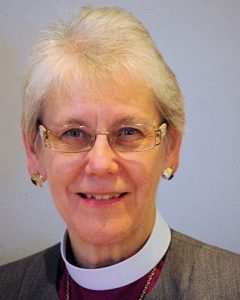
Although some people find February a dismal month as we long for the end of winter, it is, for me, a month of good memories and celebrations. Both my parents were born in February on the same day, in the same year, in the same city—and delivered by the same doctor! A beloved niece was born in this month, and I celebrate my consecration as a bishop on Feb. 2 every year.
That date, Feb. 2, is the Feast of the Presentation, when Jesus was brought to the temple as the first-born male child to be consecrated to God. While there, Mary and Joseph encounter Simeon and Anna. Both rejoice in this meeting as they see in this child the salvation that they have longed for in Israel. For centuries, we have recited Simeon’s Prayer of thanksgiving in Evening Prayer—“Now lettest thou thy servant depart in peace for mine eyes have seen the salvation of God.” What a curious story! What did they see that led them to their acclamations? Would we have seen the same?
Both were people of faith—Simeon open to the guidance of the Holy Spirit and Anna, a prophetess dedicated to worship and prayer. Steeped in their relationship with God, they remained open to the possibilities of God at work in the world around them. They set aside other expectations to welcome, without judgment, the possibility that God was present through this infant, born of parents with no status or influence in the world. They simply rejoiced.
This Epiphany, revealing God at work in the world, invites us to ask whether we are open and willing to see God in places and people we do not expect. Our sight can be clouded by expectations or habits or attitudes shaped by our culture and history. We let our expectations of God be limited. Since Anglicanism began in England, we still live with many expectations rooted in that history. Some continue to give us life while others cloud our ability to see God at work in other ways. I recall a friend from Europe commenting some years ago that the only people who seemed to be allowed to read Scripture in public worship were those with English accents!
February is Black History Month, when we honour and seek to learn more about the life and contributions of Black Canadians. Black Anglicans of Canada invites us to see the face of God in the lives and contributions of Anglicans who have found a home here from the diaspora of Black peoples. We are hearing more about their experiences of being ignored or dismissed within the life of the Church despite generations of Anglican heritage. Will we see God in those who look and speak differently than the image of our heritage?
During an ecumenical meeting at the Monastery of Bose, Italy, we were invited to visit its private collection of icons. This community writes icons in a variety of styles from around the world. I vividly recall the breadth and depth of the images and the gift of seeing God through different eyes and perspectives. That breadth is needed not only in art but in our human interactions, where God is revealed in unexpected people—a child, a beggar, a person deemed disabled, or someone different than ourselves. It is only unexpected because we choose not to see and be ready to embrace and rejoice. As 2021 challenges us to see God in new ways, let us pray for eyes to see as Simeon and Anna did—open and ready to recognize the presence of God in all around us.





